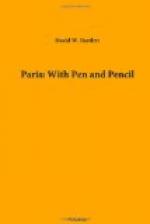Once, when in the convent at Paris, she was misled by the poetry of Catholicism, and abandoned herself to the highest transports of religious fervor. She passed whole hours in ecstasy at the foot of the altar. This shows the susceptibility of her imagination. About this time her grandmother died, and she left the convent to close the eyes of her much-loved grandparent. She returned, with the full determination of becoming religious. All the authority of her family was required to break this resolution, and, six months after, to prevail upon her to marry M. le baron Dudevant, the man they had sought out to be her husband. He was a retired soldier and a gentleman farmer. The union was a very unhappy one. She was sensitive, proud, and passionate, while he was cold, and entirely swallowed up in his agricultural pursuits. The dowry of Aurore amounted to one hundred thousand dollars, and this money M. Dudevant spent with a lavish hand upon his farm, but bestowed little attention upon his wife. At first she endured this life, for two children were given to her to alleviate her sorrows. But finding her lot grow more sad, and her health failing, she was ordered to taste the waters of the Pyrenees, whither she went, but without her husband. She rested at Bordeaux, and there made her entrance into society, through some kind friends residing in that city. She was received with praises. A wealthy shipping merchant fell deeply in love with her; she did not give way to it, however, but returned to her family, where she found no affection to welcome her.
Jules Sandeau, a student of law, spent one of his vacations at the chateau Nahant, and was the first person who turned Madame Dudevant’s attention to literary pursuits. He returned to Paris profoundly in love with the lady, though he had not dared to mention it. M. Nerard, a botanist, came also to the chateau, to give lessons to M. Dudevant, and his wife was charmed with him, and they spent happy hours together. But in time love grew out of the intimacy—a love which of course was wicked, but which according to French ideas, was innocent. The husband was justly suspicious, and a voluntary separation took place, he retaining all her property in exchange for her liberty, which he gave her, and she set out for Bordeaux. She recounts a part of her subsequent history in “Indiana.” She found her lover in Bordeaux, but he had changed, and was on the eve of marriage, and she went to Paris. She returned to the same convent where she had spent a part of her youth, to weep over her lot. She soon left the convent for an attic in the Quai St. Michel, where Jules Sandeau, the law-student, soon discovered her. She was in very destitute circumstances, and Sandeau was also very poor. She knew a little of painting, and obtained orders of a toyman to paint the upper part of stands for candlesticks, and the covers of snuff-boxes. This was fatiguing but not remunerative, and they wrote to the editor of the Figaro newspaper. He replied, and invited them to visit him at his home, where he received them with kindness. When Aurore spoke of her snuff-boxes, he laughed heartily; “but,” said he to Sandeau, “why do not you become a journalist? It is less difficult than You think.”




